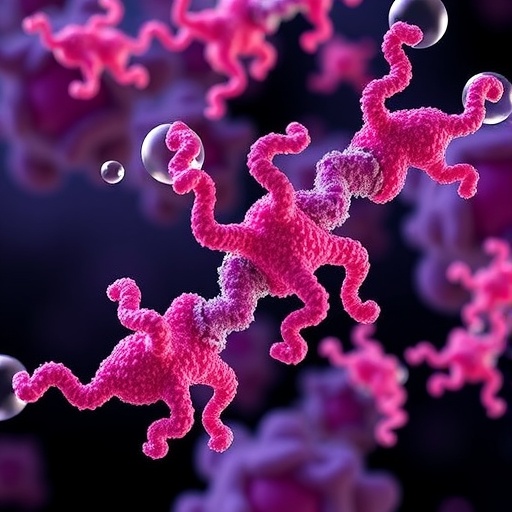In a groundbreaking study published in the highly respected journal Nature Machine Intelligence, a team of researchers led by F.C. Spoendlin has unveiled a sophisticated model designed to forecast the conformational flexibility of the complementarity-determining regions (CDRs) found in antibodies and T cell receptors (TCRs). This research delves into the intricate mechanics of how these crucial components of the immune system interact with antigens, ultimately influencing the efficacy of immune responses.
At the crux of this study lies the importance of understanding the adaptability of antibodies and TCRs, which are pivotal for recognizing and neutralizing a myriad of pathogens. CDRs are specifically tailored loops within the variable domains of antibodies and TCRs, and their flexibility plays a vital role in binding affinity and specificity. The researchers utilized advanced computational techniques to model these structural variations, emphasizing the importance of dynamic movement in the binding interaction with antigens.
Historical approaches to studying antibody and TCR flexibility often relied heavily on static structures derived from crystallography. However, these methods provide an incomplete picture, as they fail to capture the full range of conformational states that these proteins can adopt in physiological environments. Spoendlin and their colleagues noted that traditional methodologies can sometimes misrepresent the potential binding interactions. Therefore, a dynamic approach to predicting flexible states becomes imperative.
Employing machine learning and molecular dynamics simulations, the research team developed a predictive framework that allows for the assessment of conformational variability across different CDRs. This model was trained on extensive datasets comprising both experimental structures and simulated conformational ensembles. Such a comprehensive data-driven approach enhances the accuracy of predictions regarding the dynamic behavior of CDRs in diverse environments, ultimately paving the way for more refined therapeutic antibodies and TCRs.
One of the most striking findings involved the relationship between specific amino acid residues within the CDRs and the degree of flexibility exhibited. By analyzing the interactions and energetic contributions of individual residues, the authors were able to identify key positions that govern conformational variability. This insight could prove invaluable for bioengineering efforts aimed at optimizing the efficacy of therapeutic antibodies and enhancing T cell activation processes.
Furthermore, the research explores the implications of conformational flexibility on antigen recognition. The ability of antibodies to adopt multiple conformations can facilitate a more adaptable immune response, enabling the body to tackle a wider array of pathogens. Conversely, TCR flexibility is essential for achieving stable interactions with peptide-MHC complexes, which present antigens for recognition by T cells. Understanding these relationships enhances the scientific community’s capacity to design better immunotherapies and vaccines.
An essential aspect of the study highlights its potential applications in vaccine development. With a more profound grasp of how CDRs flexibly interact with antigens, researchers can tailor vaccines that elicit stronger and more targeted immune responses. This knowledge is especially pertinent in the context of rapidly evolving viruses, where traditional vaccine strategies may not suffice. By leveraging insights from the study, researchers can devise strategies to enhance the immunogenicity of emerging vaccines.
Another fascinating component of the work is its implications for affinity maturation processes. The ability to predict which mutations might bolster binding affinity and improve functional capabilities is a game-changer for antibody engineering. The findings suggest that researchers can strategically design variants of monoclonal antibodies to enhance their performance against diseases, including cancer and infectious diseases. This insight could lead to the next generation of antibody-based therapeutics that are more effective and contextually relevant.
Moreover, this study occurs amid a transformative era in artificial intelligence and machine learning applications in biology. By integrating computational tools with biological experimentation, the researchers effectively bridge the gap between theoretical predictions and experimental validations. This collaboration between disciplines exemplifies how the future of biomedical research will likely unfold, with technological advancements driving novel insights and discoveries.
As the field progresses, increasing emphasis will be placed on the integration of AI and machine learning in predicting not just antibody and TCR behaviors but other biophysical properties of biomolecules. The methods validated in this study can serve as a template for analogous frameworks applied to diverse classes of biologically relevant macromolecules, thereby extending the impact of this research far beyond antibodies and TCRs.
Additionally, the resourcefulness of this model could foster future investigations into neoantigens for personalized medicine. By mapping the flexibility of TCR CDRs and their interactions with tumor-specific antigens, researchers could develop tailor-made treatments that promise higher success rates. This personalization of cancer immunotherapy stands to optimize patient outcomes through the creation of vaccines designed to elicit TCRs that are exceptionally effective against individual tumors.
In conclusion, the study spearheaded by Spoendlin et al. marks a significant leap forward in understanding the dynamic nature of antibody and TCR CDRs. By harnessing the power of computational modeling and advanced biophysical techniques, the researchers have set a new standard for predicting the conformational flexibility of these essential immune components. As the field of immunology continues to evolve alongside technological advancements, this work lays the groundwork for further innovations in vaccine design, therapeutic antibody development, and personalized medicine approaches.
The potential clinical implications of this research cannot be overstated, as the insights gleaned from these predictive models can catalyze the development of the next generation of immunotherapeutics. The collaborative intersection of machine learning and biochemistry heralds an era of unprecedented progress, allowing scientists to unravel the complexities of the immune system with greater accuracy and foresight. Ultimately, the advancements spurred by this study will contribute to enhancing human health and fortifying our arsenal against diseases.
Subject of Research: Predicting the conformational flexibility of antibody and T cell receptor complementarity-determining regions.
Article Title: Predicting the conformational flexibility of antibody and T cell receptor complementarity-determining regions.
Article References:
Spoendlin, F.C., Fernández-Quintero, M.L., Raghavan, S.S.R. et al. Predicting the conformational flexibility of antibody and T cell receptor complementarity-determining regions.
Nat Mach Intell (2025). https://doi.org/10.1038/s42256-025-01131-6
Image Credits: AI Generated
DOI: 10.1038/s42256-025-01131-6
Keywords: Antibody, T cell receptor, conformational flexibility, machine learning, immune response, predictive modeling, therapeutic antibodies, vaccine design.




